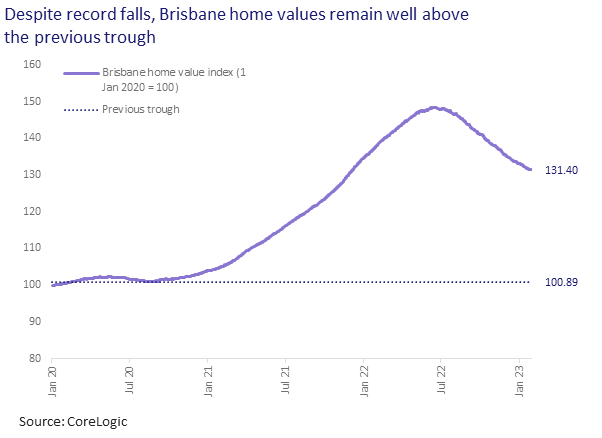Brisbane property prices fall at record pace
Brisbane property values have just recorded their largest drop ever, a mere seven months after hitting their peaking.
The tide has turned dramatically for Brisbane property, with prices recording their steepest and fastest decline on record.
Just seven months after hitting their record June high, CoreLogic’s Daily Home Value Index (HVI) shows Brisbane’s home values declined 10.9 per cent between the peak in June and 28 January, the largest percentage fall on record.
With interstate migration levels still high, interest rates have emerged as the culprit behind the real estate market’s rapid change in fortunes.
CoreLogic Head of Research Eliza Owen said the new benchmark follows hot on the heels of the national index’s record decline of 8.6 per cent.
“Brisbane now stands out as one of two capital city markets with record declines, the other being Hobart.
“Sydney continues to have the largest peak-to-trough falls of the capital city markets (currently at -13.8 per cent), while peak-to-tough falls remain mild in some cities such as Perth, where values are down just 1.0 per cent from a recent peak in August 2022,” she said.
The record fall in Brisbane home values has not made much of a dent in the gains made during the upswing.
The fall in the Brisbane daily HVI follows an upswing of 43.5 per cent between August 2020 and 19 June 2022, which was the fastest trajectory of rising values on record. This leaves home values across Brisbane 27.9 per cent higher than at the previous trough in August 2020.”

Melinda Jennison, Buyers Agent, Streamline Property Buyers, said buyer confidence had taken a hit.
“Consumer confidence levels fell sharply in the second half of 2022 and definitely impacted on buyer activity in Brisbane, contributing to suppressed demand, especially for detached housing across the city,” she said.
“The RBA started hiking rates in March 2022 yet the Brisbane market remained largely resilient, with the housing market peaking in June followed by the unit market hitting its peak one month later.
“With proposed Queensland land tax changes decimating property investors’ confidence, until scrapped in late September, this also impacted on demand across Brisbane.
“We spoke to a lot of buyers throughout this time who reported that they felt nervous about what was happening in the market and preferred to take a wait and see approach.
“When there is uncertainty in a market, buyers who are not in a rush to buy will simply sit on the sidelines and wait.
“We also observed a higher than usual number of properties sit on the market for longer, in an indication that sellers were not prepared to sell unless they achieved the price they wanted, while other properties were pulled from the market and listed for rent.”
Worst could be over for Brisbane property
Interest rates, propelled by soaring inflation, remain the main driver of national property markets.
Ms Owen said Brisbane’s housing market is adjusting to a sharp increase in borrowing costs over the second half of 2022, which have likely hit buyers hard off the back of extraordinary price rises. The median dwelling value in Brisbane has increased from $506,553 at the onset of COVID-19 in March 2020, to $707,658 at the end of 2022.
“Despite the large decline from peak, Brisbane maintains the third highest gain in value of the capital cities since the start of the pandemic,” she said.
“Only Adelaide and Darwin, which are 42.8 per cent and 29.6 per cent higher respectively than at the onset of the pandemic, have performed stronger.
“For this reason, there is marginal risk of negative equity for Brisbane homeowners, with the exception of very recent buyers, who purchased around the peak in June 2022 with less than a 20 per cent deposit.”
However, Ms Owen said some factors may be placing a floor under the market as the pace of price falls across Brisbane has been slowing in recent months.
“The first factor is relative affordability. Although housing values remain higher than pre-COVID levels, Brisbane retains a lower price point than Sydney, with a $435,170 difference in median house values and $280,749 difference in median unit values,” she said.
“The gap between Brisbane and Melbourne housing values is also significant, with a $119,697 gap between median house values and $97,692 difference in median unit values.
“This could encourage ongoing housing demand from those willing to migrate to the state, or own an interstate investment.”
Brisbane also continues to experience above average levels of interstate migration. Based on the most recent demographic data to the June 2022 quarter, migration into Queensland was tracking 63 per cent above the decade average, with net interstate migration into Queensland by far the largest across the states and territories.
Rent values increased a further 13.4 per cent in 2022, suggesting an underlying shortage of available housing across the city.
“Similarly, a low volume of listings persists, where the volume of advertised stock is trending almost 40 per cent below the previous five-year average,” Ms Owen said.
“While Brisbane property values are likely to fall further in 2023, it is possible the rate of decline will continue to slow over the coming months.”
According to CoreLogic, the largest monthly declines in median house values were recorded in August (-2.1 per cent), September (-2 per cent) October (-2.2 per cent) and November (-2.2 per cent). Since then the rate of decline has been slowing.
Ms Jennison said that the lowest levels of buyer activity were from July through to September.
“After this time the volume of people who were inspecting properties on a weekend started to gradually increase, with the exception of December where the market was very quiet.
“The start of 2023 has seen a large surge in buyers who are out and about so we expect that the worst of the negative median dwelling changes is over.”





















